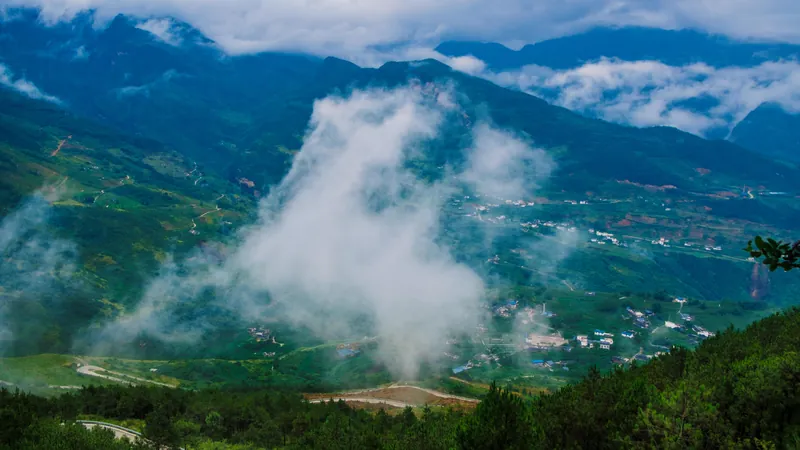
Beneath China's Surface: The Astonishing Discovery of a 400-Mile Chain of Fossilized Volcanoes
2025-07-29
Author: Jia
A Geological Marvel Unveiled
In a groundbreaking discovery, researchers have unveiled a colossal, 400-mile-long chain of extinct volcanoes buried beneath South China. These ancient geological formations date back to the chaotic times when the supercontinent Rodinia was breaking apart, a revelation that shakes the very foundation of our understanding of Earth's geological history.
The Collision of Titans
Approximately 800 million years ago, South China was part of the northwestern edge of Rodinia. Tectonic forces set the stage for dramatic interactions between the Yangtze Block and the China Ocean plate, resulting in a titanic collision. This cataclysmic event triggered the subduction process, where the denser oceanic crust was forced beneath the lighter continental crust, diving deep into the planet's interior.
From Heat to Eruption: The Volcanoes Emerge
As the subducting oceanic crust heated up, it released water that generated magma. This magma surged towards the Earth's surface, creating a curvilinear chain of volcanoes, known as a volcanic arc. This volcanic activity not only shaped the landscape but also had profound implications for Earth's early climate!
Decoding the Past: A Study of Ancient Volcanism
In a recent study published in the Journal of Geophysical Research, a team of geologists led by Zhidong Gu and Junyong Li embarked on a mission to explore these ancient volcanoes further inland from the Yangtze Block. Their findings suggest that the region’s volcanic activity extends far beyond previously mapped areas, redefining our understanding of ancient volcanic systems.
Uncovering Hidden Treasures Beneath Layers of Sediment
Pinpointing these fossilized volcanoes is no easy task; they lie shrouded beneath kilometers of sediment in what is now the Sichuan Basin. To reveal what lay hidden, the research team employed advanced airborne magnetic sensors that detect variations in rock types beneath the surface.
The sensors revealed a substantial belt of iron-rich rock approximately 4 miles beneath the ground, stretching around 430 miles and reaching up to 550 miles inland. Such iron-rich formations typically indicate significant volcanic activity above subducting oceanic crust.
A Treasure Trove of Findings
By analyzing samples from seven deep boreholes in the Sichuan Basin, the researchers confirmed these rocks originated from magma, dating back between 770 and 820 million years. Their findings support the theory that a massive volcanic arc was created during the breakup of Rodinia.
The Mystery of the Inland Volcanoes
What sets this discovery apart from most volcanic arcs, which usually form narrow belts near continental margins, is the expansive reach of the Yangtze arc. Geologists believe this phenomenon stems from a unique tectonic process known as flat-slab subduction, where the oceanic plate gently moves horizontally before plunging beneath the continent. This has produced dual volcanic ridges: one closer to the coast and another much further inland.
A Controversial but Exciting Theory
Peter Cawood, a renowned Earth scientist, praised the work as providing crucial data, although he suggested an alternative theory—proposing that these two volcanic belts could represent independent systems instead of being part of a singular arc. Regardless of the interpretation, the implications for Earth's geological history and climate are monumental.
Implications for Earth's Climate and Beyond
This discovery not only enriches our understanding of ancient volcanic activity but also invites further exploration into its impacts on Earth's climate during a critical period in our planet's history. As scientists unravel these geological mysteries, who knows what other secrets lie buried beneath the surface?

 Brasil (PT)
Brasil (PT)
 Canada (EN)
Canada (EN)
 Chile (ES)
Chile (ES)
 Česko (CS)
Česko (CS)
 대한민국 (KO)
대한민국 (KO)
 España (ES)
España (ES)
 France (FR)
France (FR)
 Hong Kong (EN)
Hong Kong (EN)
 Italia (IT)
Italia (IT)
 日本 (JA)
日本 (JA)
 Magyarország (HU)
Magyarország (HU)
 Norge (NO)
Norge (NO)
 Polska (PL)
Polska (PL)
 Schweiz (DE)
Schweiz (DE)
 Singapore (EN)
Singapore (EN)
 Sverige (SV)
Sverige (SV)
 Suomi (FI)
Suomi (FI)
 Türkiye (TR)
Türkiye (TR)
 الإمارات العربية المتحدة (AR)
الإمارات العربية المتحدة (AR)